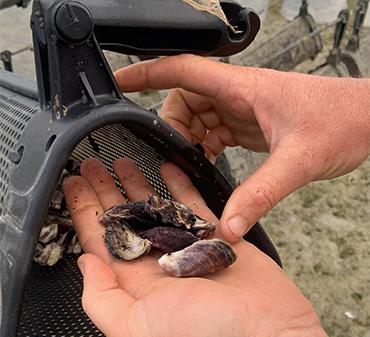A new FRDC-funded research project helps oyster farmers leverage impressive environmental credentials to improve community and consumer messaging.

Photo of person holding Moreton Bay oysters
Say oysters and most people conjure up images of romance, pearls and Champagne-fuelled celebrations. Less well-known is their ability to store carbon and clean the environment by removing nitrogen and other pollutants from the water. And this is what has some researchers truly excited.
Dr Rachael Marshall, a marine sciences PhD and consultant with leading economics and strategy firm NineSquared, has been looking into ways oyster farmers can credibly ‘prove’ their industry’s sustainability, environmental stewardship and low carbon footprint. Funded by FRDC, her findings were recently published in a 2022 strategic report.
“Compared to other protein-based food production systems, oysters have one of the lowest impacts on the planet,” says Rachael. “That is a story that [oyster farmers] can be telling right now to promote eating oysters.”
Dr Marshall says many consumers are under the misapprehension that oyster farming is an environmental negative, when, in fact, the opposite is true. “[Oysters] are kind of the ‘canaries’ of the waterways. They are an excellent indicator of estuary health, relying on healthy waterways to survive. But they also filter the water, contributing to the cleanliness of those waterways.
Positive impacts
“Having an oyster farm in a waterway is, in many ways, going to be a benefit to the health of that [ecosystem].” Dr Marshall says oyster infrastructure can also protect the benthic environment (the bottom of a waterway) from recreational fishing and trawling, encouraging sea grasses and other marine life to flourish.
Central to her work was investigating potential claims farmers could make around oysters and carbon sequestration. She found that 12 per cent of an oyster’s shell contains carbon. However, how much can be directly linked to a net storage of carbon dioxide from the atmosphere remains unknown. This is because oysters also release carbon through natural shell erosion, respiration and as a by-product of shell calcification.
Due to the relatively small amounts of carbon oysters can capture through oyster aquaculture, in the immediate future regulators are more likely to focus on developing blue carbon methodologies for higher impact carbon capture, such as the rehabilitation of wetlands and mangrove systems.
But there are some other promising pathways towards certification that emphasise the industry’s naturally proactive environmentalist approach.
“Oyster farmers are already doing a lot of what we call ‘regenerative’ or ‘sustainable farming’, just by virtue of having a successful oyster farm,” she says. “To grow a healthy oyster, you need a healthy waterway. You monitor the health of your oysters, minimise environmental stresses, and advocate for measures that ensure the health of your marine environment.
“No feed or chemicals are used to grow or harvest the oysters, so no net waste is generated. This is in contrast to most other aquaculture operations that require feed and generate some form of waste, most notably nitrogen.”
Tracking performance
Dr Marshall encourages all farmers to track and monitor the environmental benefits of their endeavours. She says the next step is towards certification pathways. This may be of particular interest for larger and ASX-listed oyster farms, to garner impact investment or to be accountable to their shareholders for their sustainable practices.
“We are seeing and hearing more stories every day about greenwashing – market spin or ‘green marketing’ used to convince consumers that products are sustainable when the claims are not always credible or trustworthy. My report highlights certification pathways of value to the industry that can help to credibly show the benefits of what they are doing.”
Accounting For Nature is a good example, says Dr Marshall. It is a not-for-profit that uses science-backed methodologies to track the condition of environmental assets across properties or regions, that is then verified by an independent third-party. “It's the first of its kind in Australia, if not the world.”
Demonstrating you are looking after or rehabilitating the environment could bring significant rewards, she notes. “The benefits may include opening up more areas to establish or expand farms, especially in sensitive areas, which could lead the industry to expand and attract new farmers.”
Given Australia exports very few oysters and the current domestic demand exceeds supply, industry expansion is now a hot topic. “Substantial research is being conducted on disease mitigation and helping to build a more resilient industry, and I think environmental condition tracking is becoming an important part of that conversation.”
The downside to certification is cost. Dr Marshall says industry members will need to work together to weigh the benefits and the willingness of farmers to pay.
Carbon conversations
Although the lack of certification is not an issue now, it may well be in the future. “We are seeing countries across the globe starting to implement new regulations around carbon footprint reporting as well as introducing taxes on imports to help countries meet climate targets.
“Whilst these are focused on the big polluters, it’s reflective of the changing climate policy and expectations that industries both consider and demonstrate how they are addressing their individual footprints and environmental impacts.”
So, while robust, highly technical and third-party verified certification such as Accounting For Nature may be a great long-term goal, Dr Marshall recommends in the meantime the industry focuses on adopting carbon neutral certifications, such as Climate Active, as a way of showing the public oyster farming is serious about low emission food production.
This is reflected in FRDC R&D Plan, Outcomes 1 and 2 and Enabling Strategies V.





